Mushroom hunting is a fun and rewarding reason to get out into the woods and enhance your normal hike. Oregon is a fantastic place to go mushroom hunting. With deep forests and consistent rains, this land is a mushroom’s (and mushroom hunter’s) dream!
Oregon has a great climate for mushrooms to grow in and, thankfully, the state allows mushroom hunting on most lands, more than most states.
It’s helpful that there aren’t many laws or regulations to worry about, but there is a lot to consider with mushroom hunting. It’s important to know how to identify the common toxic mushrooms, as well as any edible ones you plan to collect, where you can find mushrooms, and what time of year to go.
This might seem like lots of information but it’s actually pretty simple to learn and get started. With this complete guide, you have all the basic information in one place to start learning about mushroom hunting in Oregon!
Getting Started
Unfortunately, a lot of people are intimated by all the knowledge there is to learn or they’re too worried about eating a toxic mushroom, so they never start mushroom hunting. But it’s much easier and simpler than most people realize!
While it’s important to know the risks and be serious about what you’re picking- and eating- mushroom hunting really isn’t a difficult hobby to get into.
First off, there are only a handful of mushrooms in the whole world that are toxic enough to kill you, so these are the minority in the forest.
Also, you don’t need to be an expert to go walking through the woods and try to identify the mushrooms you find. You should only ever eat a mushroom if you’re 100% sure what kind it is, but don’t let this stop you from looking for mushrooms and testing your knowledge!
It’s very important to do lots of research so you’re not going in blind but you don’t need to know everything there is to know before you go out. Also, you can’t know everything there is to know until you’re actually in the forest hunting!
Resources
There are tons of guides and websites with useful information on identifying mushrooms, so you should never feel like there aren’t answer to your questions.
A great website for learning about mushrooms is Fungi for the People with tons of educational information. For the northwest specifically, there is the Pacific Northwest Mushroom Identification Forum.
One great way to build up knowledge about identifying and foraging is to join a local group. In Oregon, there are several groups that meet to go on guided walks, do workshops, and share information.
You should consider joining a group to increase your knowledge and meet other mushroom hunters! Here are a few major groups in Oregon:
- Oregon Mycological Society
- Cascade Mycological Society
- Willamette Valley Mushroom Society
- Central Oregon Mushroom Club
Another way to get involved in the scene is to see the annual Mushroom Festival in Eugene!
Laws About Mushroom Hunting
Oregon is one of the most accepting states when it comes to laws and permitted lands for mushroom collecting!
You’re allowed to collect up to one gallon of mushrooms per person and per day in the national forests. This includes Siuslaw, Malheur, Umatilla, Wallowa-Whitman, Deschutes, Fremont-Winema, Umpqua, and Willamette National forests.
You can also collect mushrooms in state forests, with a limit of one gallon per vehicle. This is for the state forests in districts Astoria, Tillamook, Forest Grove, North Cascades, and West Oregon.
Oregon is one of the few states that allows collecting mushrooms in state parks as well! The state parks have a limit of five gallons of mushrooms per person per day.
For national forests, state forests, and state parks, you don’t need a permit as long as you keep to the allowed limits and the mushrooms are for personal consumption. You’ll need a special permit to collect higher amounts or sell the mushroom you found.
It’s not allowed to collect mushrooms growing on campgrounds.
You can collect mushrooms growing on private property with the permission of the owner. This of course means that you can harvest mushrooms growing on your own land too!
General Foraging Rules
Along with the laws on mushroom hunting. there are some general rules that we follow to forage in a responsible and respectful manner.
The main rule, which goes for foraging of any kind, is to only take as much as you’ll use. It can be really exciting to find something edible- especially as a beginner- and you may be tempted to take as much as you can. But, keep in mind that what you’re collecting is also food for forest animals and it doesn’t help anyone if it’s rotting in your fridge!
Specifically for mushrooms, always “tap the cap” to release the spores in the cap, so that more mushrooms can pop up! The spores in mushrooms are like the seeds in fruits- it’s how they reproduce so helping them release their spores supports new mushroom growth.
When you’re ready to pick the mushroom, grab it from the base and gently pull so you don’t tear the mushroom. Some foragers bring a pocket knife to snip mushrooms but this isn’t necessary.
Lastly, be mindful and keep your eyes open! Mushrooms are all connected by an underground mycelial network. If you spot one mushroom, it’s likely that there are several more around it. Be careful not to step on another while you’re going in to collect!
Common Edible Mushrooms
While there are only a few deadly mushrooms, most mushrooms aren’t edible simply because they don’t taste great or are too rough. However, there are a few mushrooms that are super tasty and are loved by chefs- these are called “choice edibles.”
There are several choice edibles that grow throughout the U.S. and Oregon is home to a couple of them!
King Bolete (Boletus edulis grandedulis)
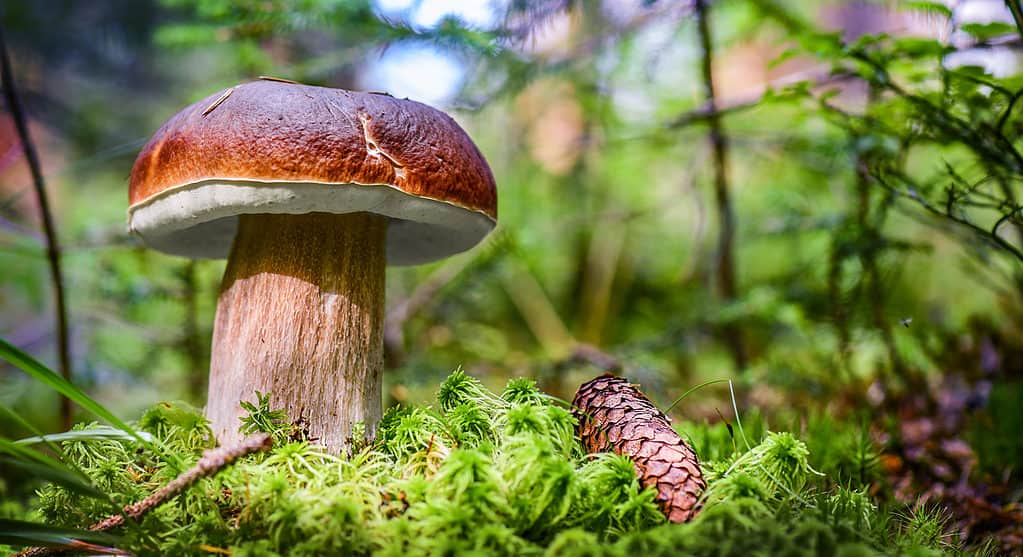
Of the many species of
bolete
mushrooms, king bolete mushrooms are considered the tastiest.
©Krasula/Shutterstock.com
King bolete mushrooms can be found all along the Pacific coast of North America. King bolete is one of many species of bolete mushrooms but it’s the tastiest and, therefore, most well-known.
In many parts of the U.S., this mushroom is called “king bolete,” but it’s actually the same mushroom as the Italian porcini. So, it can be used in any recipe that calls for porcini mushrooms!
King boletes are pretty easy to identify. The major thing to look for is the “sponge” on the underside of the cap. Many mushrooms have gills but Boletes have a thick sponge. So, you can disregard any mushroom that you think is a bolete but has gills.
King Boletes have a thick white stipe (stem) and rounded brown caps. The younger ones will have a firmer cap and this is better to eat than the older, squishy ones.
Boletes often grow in symbiosis with pine trees. They can also be found near Douglas fir, oak, Sitka spruce, or birch trees. They need at least two inches of water to pop up, so look out after summer and fall rains.
Pacific Golden Chanterelles (Cantharellus formosus)

Common on the west coast of the United States are Pacific golden chanterelles.
©Randy Bjorklund/Shutterstock.com
There are several species of chanterelles that are edible and they’re all loved around the world. Pacific golden chanterelles are very common on the west coast of the U.S. These mushrooms are also well-known for their bright orange color.
Not all Chanterelles are orange but often when we see photos of Chanterelles, it’s these pumpkin-orange ones. They have an orange cap and an orange-white stipe.
Be careful though, there’s another orange-colored mushroom that resembles the chanterelle but is toxic! This is the jack-o’-lantern mushroom with the same pumpkin coloring, but a different shape and form, so look closely!
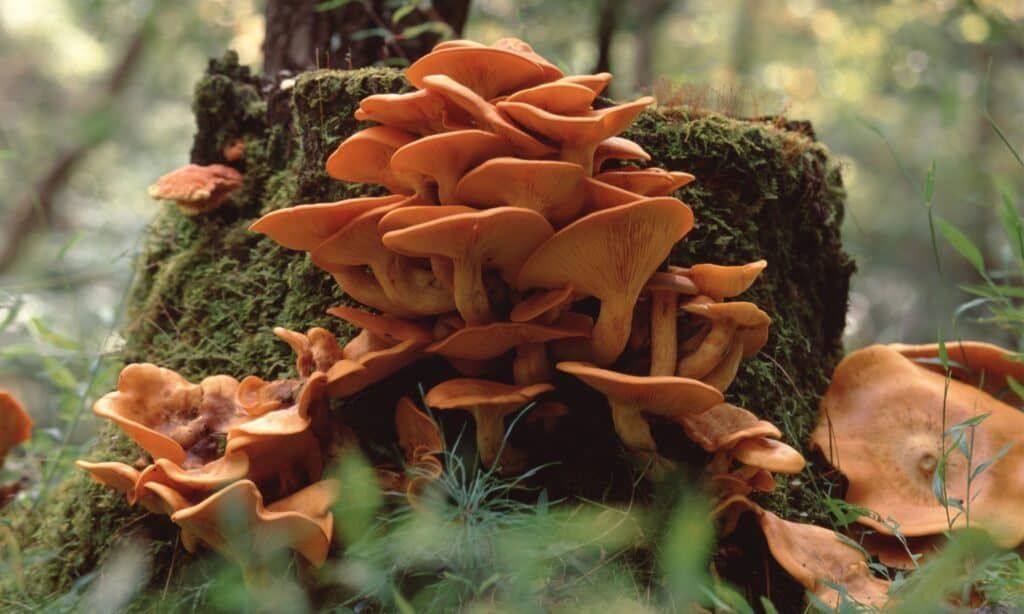
Found only in
Japan
and North America, jack-o’lantern mushrooms resemble chanterelles. Unlike chanterelles, they are toxic.
©iStock.com/Weber
Chanterelles are trumpet-shaped, with their stipe blending into the wavy-edged cap. An easy way to identify chanterelles is to peel a piece away, it should peel off in the same way that string cheese does.
These mushrooms also need lots of moisture to pop up. They like to come around late summer and early fall, after lots of warm rains. They often grow with Douglas Fir, Pine, Oak, Western Hemlock, or Birch trees.
White Matsutake (Tricholoma magnivelare)
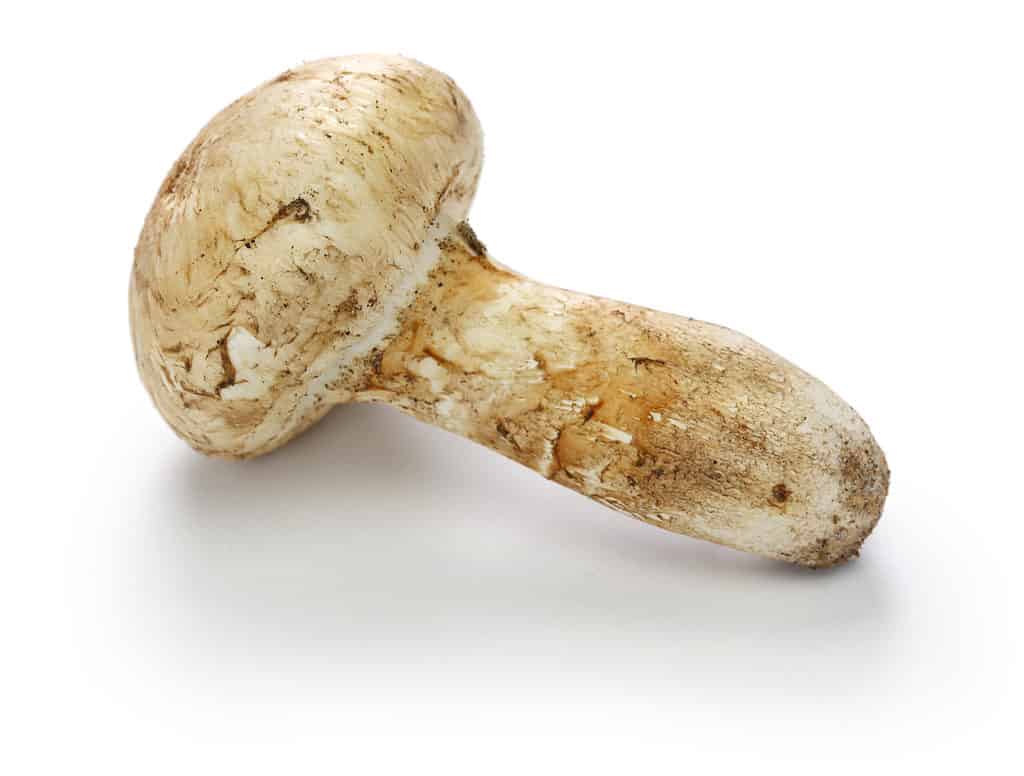
While they grow in Japan and are popular there,
matsutake
mushrooms also grow in the pacific northwest of the United States.
©bonchan/Shutterstock.com
Matsutake mushrooms grow all over Japan and are highly popular for their cuisine. Thankfully for us, they also grow well in the pacific northwest! Specifically, the white matsutake, which has a unique cinnamon-umami flavor.
White matsutake mushrooms have different regulations for collecting than other mushrooms. You need to have an authorizing letter that permits you to collect them. Often, you can download this paper (for free) on the website of whatever national forest you’re going to, so check there!
Matsutake mushrooms are quite large; usually several inches tall with a long stipe and wide cap. These mushrooms can be mistaken for deadly Amanitas, so it’s advised to work your way up to collecting matsutakes.
These mushrooms pop up first at higher elevations. Then, as fall goes on, they can be found in most forest terrains. They often grow with fir, western hemlock, and Ponderosa pine trees.
Toxic Mushrooms in Oregon
Along with knowing the common edible mushrooms, it’s important to know the basics about some toxic mushrooms you could come across. These toxic mushrooms aren’t super common, but it’s good to have an idea of what you should avoid.
Amanita ocreata and phalloides
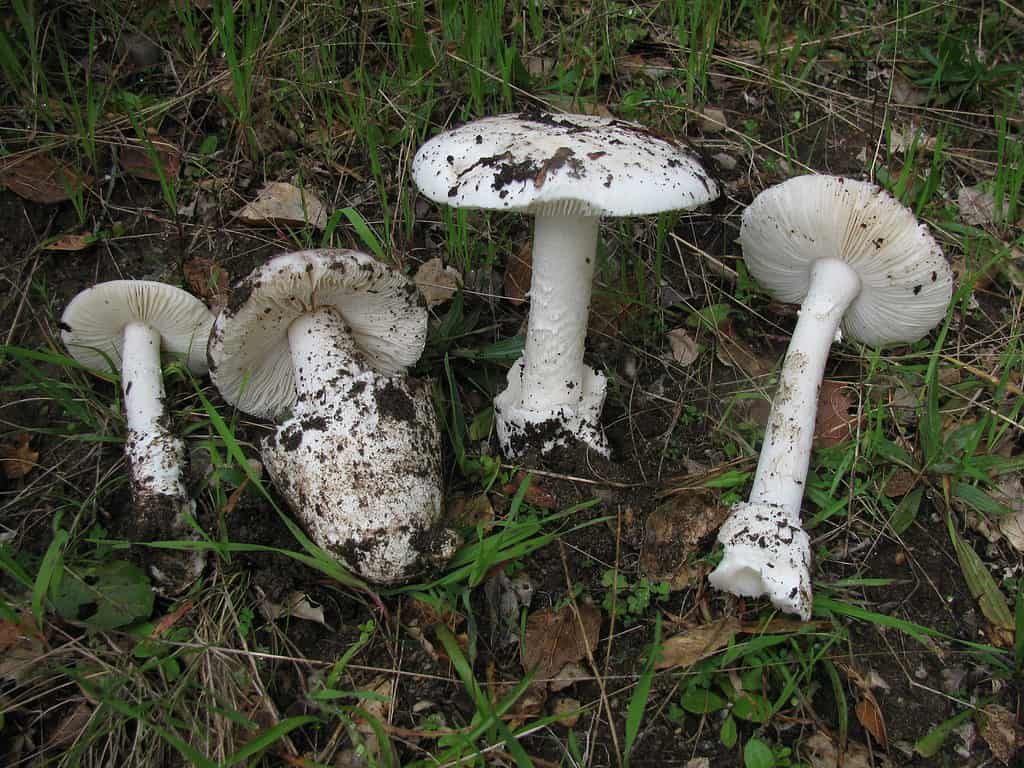
With amatoxins that cause liver failure,
Amanita ocreatacan be deadly if ingested.
©This image was created by user Ryane Snow (snowman) at Mushroom Observer, a source for mycological images.You can contact this user here.English | español | français | italiano | македонски | മലയാളം | português | +/−, CC BY-SA 3.0 <https://creativecommons.org/licenses/by-sa/3.0>, via Wikimedia Commons – License
Two that you should absolutely not pick are Amanita ocreata, also known as the “Destroying Angel,” and Amanita phalloides, also known as the “Angel of Death”— both aptly named. These two are some of the most toxic of the Amanita genus. They have amatoxins that cause liver failure, leading to death.
They’re both foreboding mushrooms that are several inches tall with large caps also several inches across. However, when they’re young both of these toxic mushrooms go through an “egg phase” where they resemble small, spherical puffball mushrooms.
The Amanita ocreata is a bright white mushroom and Amanita phalloides is white with a yellow or brown tint. Because of these two, I have a general rule of never picking white mushrooms, just to be safe (even though there are edible white mushrooms).
Galerina marginata
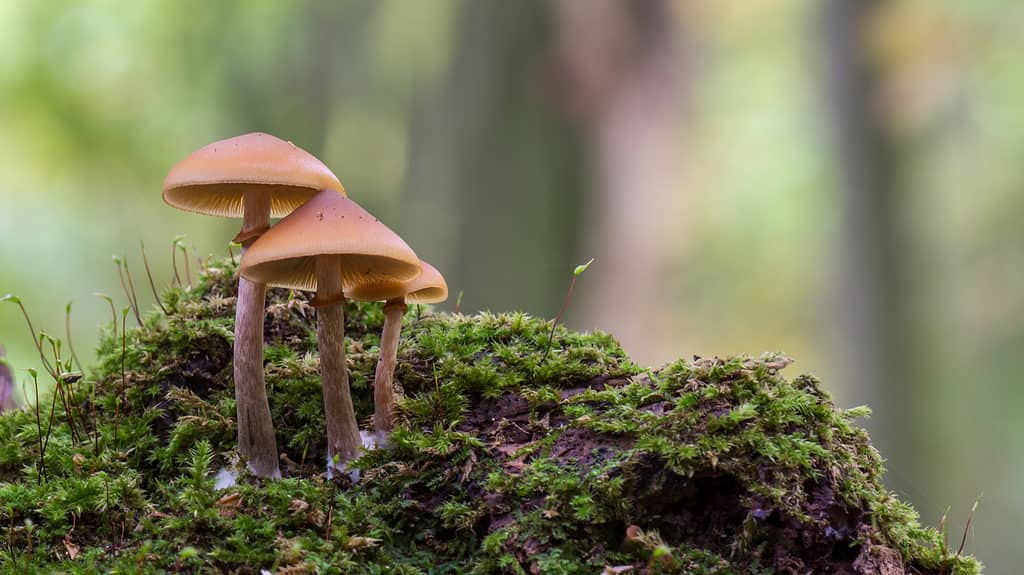
The most deadly mushroom of the
Galerinagenus is the
Galerina marginata.
©Jolanda Aalbers/Shutterstock.com
There are a few toxic mushrooms in the Galerina genus, but the Galerina marginata is the most deadly. It contains toxins that lead to liver failure, giving it its names “Funeral Bell” or “Deadly Galerina.”
The Galerina marginata is a small mushroom, only a few inches high, with a slender stipe (stem). They often grow on dying wood and moist places. Usually, there are several growing near each other, but they don’t grow in clusters.
Galerina marginata mushrooms have brown-beige caps that lose their color over time. The caps are rounded, like a tiny umbrella. Galerina marginatas have gills like many other small brown mushrooms so they’re difficult to identify. Another reason to confirm you’re 100% sure of your find!
Where To Go Mushroom Hunting
Of course, you need to start by going to an area where mushroom hunting is allowed, like the national forests or state parks. But once you’re there, where do you go? Many of these forests and parks are huge and you could wander for days and find nothing if you don’t know where to look.
Now, the best way to find the hot spots is to ask an experienced mushroom hunter who’s been in the area for years. However, not all mushroomers are eager to give away their trusted spots.
It also helps to join one of the local groups I mentioned earlier in this post. The guides or fellow members of those groups are likely to share some tips on where to go looking.
Each mushroom has a preferred habitat, so if you’re searching for a specific one you should look up where to find that mushroom. Thankfully, there are some basic guidelines you can follow when looking for mushrooms.
First off, all mushrooms need moisture to pop up. So, areas that accumulate moisture are prime for mushrooms. This could be streambanks, soaked logs, mossy stumps, or soil covered in damp, fallen leaves.
Many mushrooms also grow symbiotically with certain trees, exchanging vital nutrients. So, you’re likely to find mushrooms growing at the base of living trees, although the species of the tree depends on the species of mushrooms.
Often, you need to go off the trails a bit to find areas that others haven’t searched or that aren’t disturbed by hikers. Don’t forget to check under ferns or bushes as they can sometimes hide budding mushrooms.
Specifically for Oregon, parks and forests along the coast are known to be great hunting spots because of the wet and humid climate. Also, the Cascade Mountains are loved by local mushroom hunters for harboring lots of species of mushrooms.
One important thing to keep in mind is to keep your eyes open! Many species of mushrooms grow together in “troops.” So, if you spot one, it’s likely that there’s more nearby!
When To Go Mushroom Hunting
As with where to go looking, the ideal season to go mushroom hunting highly depends on the species of mushroom you’re looking for. Many grow well with late summer and early fall rains, but some species prefer the warmth of the spring.
Generally speaking, mushrooms can be found from August to May. Mushrooms can be found growing all year long, but the specific season is really a matter of what species.
Morel mushrooms and many species of Truffles grow in spring because they like the warming temperatures and fresh spring rains. Many species, like Chanterelles, grow in late summer as the temperatures cool and fall rains bring moisture.
Some species have longer seasons too. For example, Bolete mushrooms normally grow in late summer to fall but are known to erratically pop up in late spring.
There are many factors that affect mushroom growth and even experienced mushroomers can’t exactly determine when mushrooms might pop up. We do know that moisture is the main prerequisite, both in the air and the ground.
So, mushrooms are most often popping up with spring and fall showers. This is why mushrooms aren’t often found during the summer, during the peak dry season. However, a wet summer can be very advantageous for mushroom growth!
A serious chill often inhibits mushroom growth and normally after the first frost mushrooms stop popping up. So, generally, winter isn’t the prime mushroom season, but there are a few species that can tolerate low temperatures and will keep going.
Let the Hunt Begin!
You should always be cautious when foraging for mushrooms but if it’s something you’re interested in, you just need to get started! You can continue building your knowledge of mushroom hunting for all your life if you want to.
There’s so much to learn about in the funky world of fungi — and so much that we’re discovering — that you can’t expect yourself to learn it all. Plus, you can’t know it all until you’ve actually gone out into the forest and started observing.
Field guides and posts like this are great for getting a basic understanding but to really build your knowledge, you have to start finding and interacting with mushrooms.
I hope that this article helped you learn about mushroom hunting in Oregon so that you better understand the scene and resources available to you. If you’re here, it means you’re curious about mushroom hunting and you should follow that curiosity into the forest!
DISCLAIMER: Always check with a mycologist to confirm your findings and before ingesting.
Up Next…
- The 6 Best Books About Mushrooms for Beginners and Enthusiasts!
- The 7 Best Children’s Books About Mushrooms for Facts, Encouragement, and Foraging!
- What is the Best Month for Mushroom Hunting?
- 8 Different Types of Poisonous Mushrooms You Should Avoid
The photo featured at the top of this post is © Krasula/Shutterstock.com
The information presented on or through the Website is made available solely for general informational purposes. We do not warrant the accuracy, completeness, or usefulness of this information. Any reliance you place on such information is strictly at your own risk. We disclaim all liability and responsibility arising from any reliance placed on such materials by you or any other visitor to the Website, or by anyone who may be informed of any of its contents. None of the statements or claims on the Website should be taken as medical advice, health advice, or as confirmation that a plant, fungus, or other item is safe for consumption or will provide any health benefits. Anyone considering the health benefits of particular plant, fungus, or other item should first consult with a doctor or other medical professional. The statements made within this Website have not been evaluated by the Food and Drug Administration. These statements are not intended to diagnose, treat, cure or prevent any disease.
Sources
- Oregon Discovery, Available here: https://oregondiscovery.com/oregon-mushroom-picking-guide
- Travel Oregon, Available here: https://traveloregon.com/plan-your-trip/guides-tours/tours-guided-trips/beginners-guide-to-mushroom-foraging-in-oregon/
Thank you for reading! Have some feedback for us? Contact the AZ Animals editorial team.







